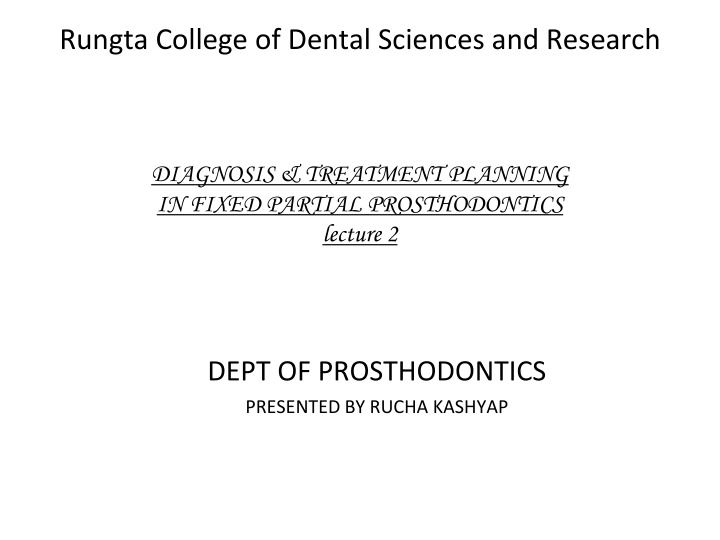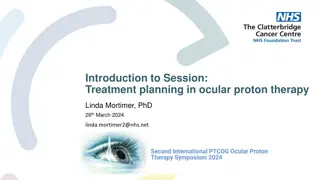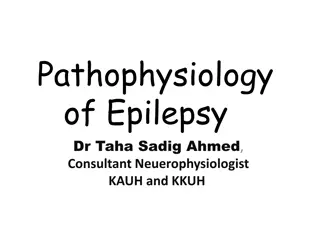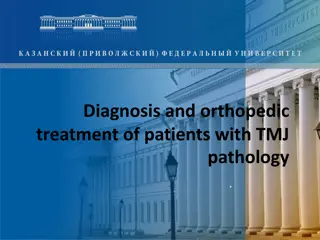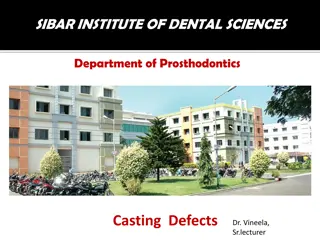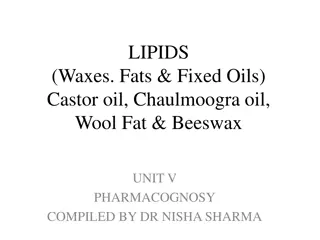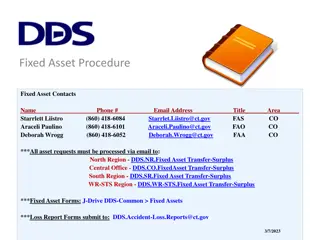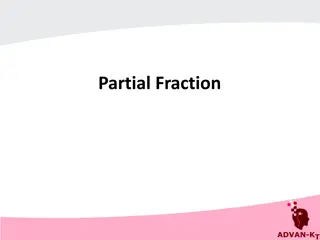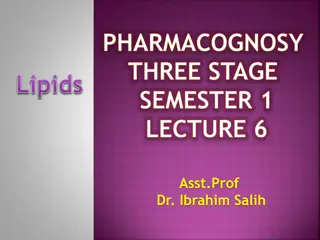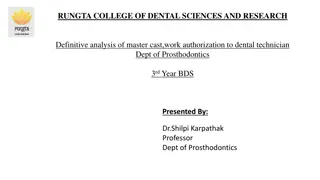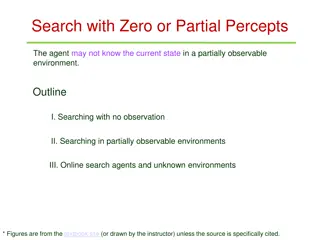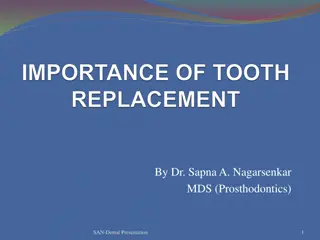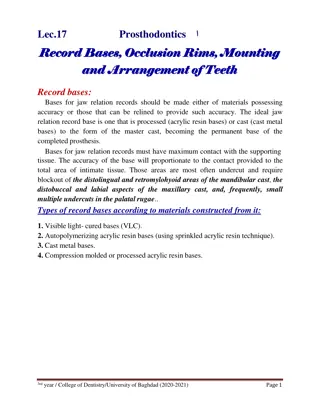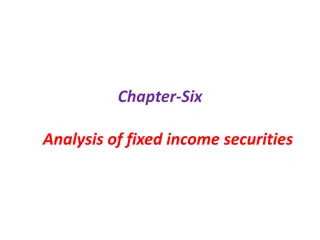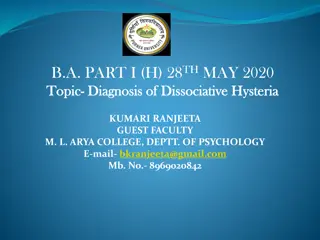Comprehensive Approach to Fixed Partial Prosthodontics Diagnosis and Treatment Planning
This lecture covers the essentials of diagnosis and treatment planning in fixed partial prosthodontics, focusing on recording case history, intraoral examination, and formulating treatment plans. Topics include oral examination, assessment of teeth, occlusal examination, periodontal examination, and the use of diagnostic casts. By the end of the class, students will be equipped to describe oral assessment techniques, perform examinations, and create effective treatment plans.
Uploaded on Sep 11, 2024 | 1 Views
Download Presentation

Please find below an Image/Link to download the presentation.
The content on the website is provided AS IS for your information and personal use only. It may not be sold, licensed, or shared on other websites without obtaining consent from the author.If you encounter any issues during the download, it is possible that the publisher has removed the file from their server.
You are allowed to download the files provided on this website for personal or commercial use, subject to the condition that they are used lawfully. All files are the property of their respective owners.
The content on the website is provided AS IS for your information and personal use only. It may not be sold, licensed, or shared on other websites without obtaining consent from the author.
E N D
Presentation Transcript
Rungta College of Dental Sciences and Research DIAGNOSIS & TREATMENT PLANNING IN FIXED PARTIAL PROSTHODONTICS lecture 2 DEPT OF PROSTHODONTICS PRESENTED BY RUCHA KASHYAP
Purpose Statement At the end of the class the students will be able to describe how to record case history, do intraoral examination and formulate a treatment plan
LEARNING OBJECTIVES At the end of the class students should be able to Sr No. Learning objectives Domain Level criteria conditi on 1. Describe how to do general oral assessment, examination of teeth. Cognitive Must All know 2. To learn to do occlusal and periodontal examination Cognitive Must All know 3. Discuss how to formulate treatment plan cognitive Must know
CONTENTS Intra oral examination Importance of radiographs Diagnosis Occlusion Esthetics Treatment planning Abutment selection Endodontic consideration Summary
Oral Examination General oral assessment: Evaluation of :- Oral Hygiene Overall caries activity General periodontal status & Type of saliva
Examination of teeth Each tooth is examined for: Dental caries Decalcification Erosion Abrasion Occlusion Attrition Hypersensitive exposed root surfaces
Occlusal Examination The following are also noted: Vertical & horizontal overlap of the anterior teeth occlusal plane Vertical dimension of occlusion Any missing or supraerupted teeth Rotated teeth Any evidence of bruxism
Periodontal Examination Gingiva is observed for abnormalities in color, size, shape, consistency or texture, as well as areas of recession The periodontal probe scrutinizes the periodontal pockets, furcation invasions & mucogingival defects. Mobility patterns of teeth are evaluated
Diagnostic Casts They are used to evaluate: Soft tissue contours Vestibular morphology & frenum attachments Bony contours Crown length & morphology Tooth alignment & path of insertion Available pontic space
An intra-oral radiographic examination reveals: Remaining bone support Root number & morphology (short, long, slender, broad, bifurcated, fused, dilacerated etc.) & root proximity Quality of supporting bone, trabecular patterns & reactions to functional changes
Pulpal morphology & previous endodontic treatment Presence of apical disease, root resorption Retained root fragments, radiolucent areas, calcifications, foreign bodies or impacted teeth
Definitive Diagnosis After a careful review of all available information, a definitive diagnosis is made Dental diagnosis commonly includes: Determination of the periodontal health Occlusal relationships TMJ function Conditions of edentulous areas Anatomic abnormalities etc.
Treatment Planning Consideration s in treatment planning: 1. Patient s desires, expectations & needs 2. Systemic & emotional health Elderly or debilitated patient s, unable to tolerate long appointments of FPD treatment may better served with more conservative care i.e. removable prosthesis
Occlusion Every fixed restoration affects occlusion. Our aim should be Do not harm when restoring occlusal surfaces of teeth
Occlusal restoration with fixed prosthodontics should result in : Simultaneous equalized contact of all teeth (ant & post) maximum intercuspation (centric occlusion) at a physiologic vertical dimension of occlusion in A physiologic plane of occlusion
Esthetics Patient s concern with esthetics should not be underestimated Every effort should be made to produce an esthetic result without compromising functional requirements Porcelain has excellent esthetic potential.
Endodontic Considerations Endodontically treated teeth can successfully function as abutments to an FPD. However, a post and core is usually required as these teeth are weakened by the loss of supporting dentin
Abutment Selection Bone support: Ante s Law: Abutment teeth should have a combined pericemental area equal to or greater than the tooth/teeth to be replaced Other equally important parameters: Crown to root ratio Root morphology Occlusal conditions
Crown-root ratio Favorable crown: root ratio is 1:1 . Poorest prognosis: teeth with short, conical or blunted roots Best prognosis: Irregularly shaped roots or with divergent multiple roots Favorable crown: root ratio
Comprehensive planning-A comprehensive sequential approach to treatment planning is essential. Prognosis-The dentist should propose a treatment plan that offers a favorable prognosis. The less disease present at the onset and the less complex the treatment, the more favorable the prognosis.
Successful treatment is the result of a logical diagnosis and a rational sequence to the treatment plan. A comprehensive oral examination, distinct radiographs and well defined diagnostic casts are essential ingredients for diagnosis. The approach to treatment planning should be meticulous, flexible and scholarly.
TAKE HOME MESSAGE The clinicians who familiarize himself with precision attachments will add a new dimensions to his treatment options Proper maintenance and care by the patient and regular follow up decides on the long term success of the attachment and prosthesis. 22
Bibliography 1. Rosenstiel R.F., Land M.F., Fujimoto J. : Contemporary fixed prosthodontics. 1st Ed., Mosby Publications, 1988. Pg 3-45 2. Shillingburg H.T., Hobo S., Whisett L.D., Jacobi R., Brackett S.E. : Fundamentals of fixed prosthodontics, 3rd Ed., Quintessence Publication, 1997.Pg 1-9 3. Tylman S.D. Theory and Practice of Crown and Bridge Prosthodontics. Ed. V St. Louis 1965. C.V Mosby Company. Pg 1-23
QUESTIONS EVALUATION OF ABUTMENT TEETH DIAGNOSTIC CAST AND ITS IMPORTANCE IN FPD PIER ABUTMENT AND ITS SIGNIFICANCE DOUBLE ABUTMENT
